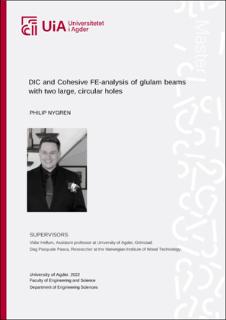| dc.description.abstract | Introducing a large hole into a load-bearing timber beam causes stress concentrations in the hole vicinity. Tensile stress perpendicular to the grain presents a particular crack initiation and propagation risk. Unfortunately, beam design with holes is not integrated into the current Eurocode 5, even though research has proven that reinforcement can prevent premature failure of holes with a diameter up to 40 % of beam height. This thesis has addressed even bigger holes by analyzing the fracture behavior of holes constituting 57 % of beam height. Four glulam beam experiments utilizing a standard four-point bending setup, each with two consecutive large circular cavities within the shear and moment region. Two of the beams had glued-on plywood reinforcement. High-resolution images got captured utilizing a dual-camera Digital Image Correlation (DIC) setup to study displacement fields in an area surrounding the holes. In addition, the ACDM tool automatically detected cracks by DIC-data, which enabled the computing of the crack length in MATLAB. Moreover, a Finite Element (FE) model was created in ABAQUS with cohesive layers to apply non-linear fracture mechanics considerations to the model, with a bilinear traction-separation behavior.
The analysis of the two unreinforced beams uncovers crack initiation to begin at the hole closest to the support, at an approximate inclination of 45°, caused by tension perpendicular to the grain. The two reinforced specimens did not experience crack development near holes, and failure was due to tensile bending in the middle of the beams. The numerical FE-analysis overestimates capacity when using an initial, literature-based guess of parameters, and subsequently, cracks initiate at a later loading stage compared to the experiments. Although this is not validated, reducing crack initiation capacity in fracture modes I and II will reduce the difference between model and experiments. Therefore, a model-updating procedure is suggested based on a stochastic optimization algorithm identifying the error between the model's DIC-measured strain-field points and crack length. More research is necessary to validate the proposed procedure and larger sample sizes to conclude if reinforcement of large holes can retain its strength as if the beams would have been intact. | |
